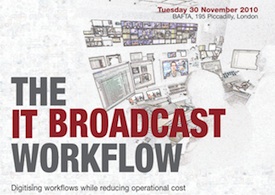
IT Broadcast Workflow 2010: Orchestrating workflow efficiency at Chellomedia’s DMC and outlining the benefits of moving to a digital workflow leading to quality and service improvements.
Chellomedia, the European content division of Liberty Global, plays out 63 channels from its Digital Media Centre in Amsterdam, such as Discovery, in multiple languages, with multiple subtitles and audio files. “So, it’s a complicated workflow that we needed to automate,” said Rick Phelps (pictured), its head of quality and reporting.
It is endeavouring to remove almost all of the manual tasks in its workflow, to become mistake free, and has installed a somewhat unconventional set up without a Media Asset Management system. It is about two years into a three year project. By the end of 2011 everything should be in place, if all of its clients can deliver digitally by then.
Key technology includes Pilat Media’s Integrated Broadcast Management System, which is its orchestrator; Signiant, which moves files from external sites and internally within the facility; Anystream for transcoding; Suitcase TV, for deep archive and track stacking, plus some quality control; IBMS Workflow, which it uses as a gatekeeper; OmniBus iTX and Colossus automation; and Omneon servers.
Outlining the benefits from moving to digital workflow, Phelps explained: “We now have one interface, so there is a lower cost of overall user support. The users can go to one system to see everything that they need to do within the whole workflow.” Costs are lower for shipping stock for it and its customers, as it is now file-based, so has no more tapes, CDs or DVDs being sent; things that were previously done by traffic operators are now automated, so you can reduce staffing costs; and there are better synergies between its sites across Europe and with its clients, leading to improved efficiency.
“We can increase our service offerings, because we are a third-party playout facility. With these digital workflows, we can now do things for our clients that they normally had to do themselves and they can rely on our infrastructure to do that type of work,” said Phelps.
To automate its workflows, it is now driving file-based delivery from clients – “90% of our components right now are digitally delivered. We still have some clients that deliver tapes, which is HDCAM or Digital Betacam, so the goal for next year [2011] is to have all or the majority of that digitally delivered.” Today, about 60% of its HD and SD long form content is delivered digitally, about 85% of promo material, all commercials, audio and subtitle files.
It has moved to full automation of inbound files, so there is no more traffic handling. Its gatekeeper examines the file to make sure it has been requested, and checks its validity, integrity and file attributes, so that there is nothing within the workflow that shouldn’t be there. It also makes sure that if there is a problem with a file it is caught up front and dealt with.
It has rules-based workflows, which are driven by QC statuses within the systems, by version profiles it has set up, and component templates.
It has dynamic links to internal systems, via web services, encompassing its STV, Omnibus, Anystream and IBMS systems. “They all know what the other one is doing. You need to have that in order for everything to work correctly.”
It is currently undergoing a staff reorganisation, “because we don’t have traffic operators anymore with the automated workflows, we’re focussing on media managers and quality control people as a change of what we do” operationally.
Because of the changes he believes that DMC is able to offer its customers improved services and quality.
Service improvements include: lower costs “because they can use our infrastructure to do some of the work that they did in the past”; efficient repurposing, “with one click they can repurpose some of their assets” to go to a different application, such as VoD; and global reach (playing out everywhere except the US and South America).
Quality has improved because of the automatic gatekeeper; comprehensive QC versions, “when they’re complete we do the quality control at that stage rather than doing it in bits and pieces along the way”; and data integrity — “with no manual entry, mistakes aren’t made anymore”.
The last statement was picked up later by conference chairman Jeremy Bancroft: “That’s a very brave thing for a broadcast person to say,” he observed.
By using the gatekeeper, the idea is that “if a mistake would be made, it should be made external from us. If the file comes in and there is something wrong with it then we give that feedback to the external facility house immediately,” responded Phelps. If something is allowed into the workflow “there shouldn’t be any mistakes”.
It has also successfully streamlined the management of multi-lingual programming, thanks to rules-based workflows. These rules are established at the Deal level – “We create Deals within our system and these drive the workflow based on version profiles and component templates.” There is also automated delivery of proxy templates. “We have a browse archive, which we include in our workflow, so at the Deal level when the file comes in we repurpose that into proxy files,” he explained.
The gatekeeper provides instant feedback to facility houses. “So when a file comes in, and we find out something is wrong with it, we can immediately send feedback to the facility house that sent us that originally and they can send us a new file.” There is also automated inbound processing, which means that material can be delivered a lot closer to transmission (”as close as two hours” but the facility house has to be able to deliver something that is transmission ready).
Before the change, more than 30 elements of its workflow (about half the total number) were manual. Almost all of these have been eliminated or soon will be. “Pretty much 99% of all the manual tasks will disappear, except for quality control. The only time we’ll need someone to look at something within the workflow is when something goes wrong.”
At the heart of the system is IBMS, which “manages everything from your content acquisition through to your planning, presentation schedule, your libraries, all the way through to selling inventory, selling spots into your content, wherever it is being broadcasted or being placed for downloads,” explained Yuval Tori, VP sales, EMEA, Pilat Media. IBMS can be used in a very modular way, although it is a single database system, “some people use it only for scheduling, and some people use it end to end.”
Through the introduction of new tools, such as its workflow engine, the system now allows users to be much more self-sufficient. It consists of a workflow designer, which “allows you to manage the whole workflow underlying the whole of the system in a very easy way,” without the need to write any code, and workflow monitor.
Within IBMS, users at DMC create a Deal. This consists of a version profile and a component template, and automatically creates requests against that, which then trigger the workflows to do tasks such as to create a file in the browse archive, accessible by facility houses so that they can retrieve material such as proxies or scripts. It also creates requests for language files or subtitles.
Facility houses return them together with XML that includes metadata. This is read by IBMS (telling Anystream if any transcoding needs to be done), which automatically creates a match and moves it on to QC (in transmission order). Once QC is done, IBMS moves the file to the archive and makes it available for scheduling.
For on-screen graphics it currently sends out a flat file schedule but is looking at dynamic links between IBMS and its automation system using the DXF file format, including a way that a scheduler or on-air person can make a change that will also drive graphic devices near to air time.
Unlike many installations, DMC has no recognisable Media Asset Management system. It did start a project to look at MAM systems, “but what we found is that if you just basically draw a circle around all those components that you have in there, with a good orchestrator in there, which is IBMS, that maybe we already have a MAM,” said Phelps.
Pilat Media doesn’t “have any intentions of replacing MAMs altogether,” added Tori. “The DMC implementation is unique in the way we described it. IBMS is a broadcast management system. We see it as the main orchestrator of things. IBMS cannot do transcoding. IBMS cannot do archiving. IBMS can actually not even move files from one place to another. What it can do is orchestrate the process; allow the TV operator to design it, monitor it, identify bottlenecks, and streamline the whole operation. I know it’s a very blurry demarcation line, but this is the industry today. This is where we see we are very much a back office system.” – David Fox







